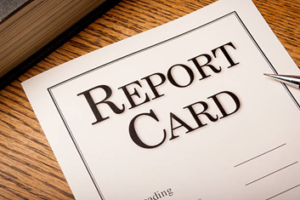 Grades, oh, my God, grades, the bane of my schooling years, as I followed along in the wake of my smart, “A” student, big sister and never measured up.
Grades, oh, my God, grades, the bane of my schooling years, as I followed along in the wake of my smart, “A” student, big sister and never measured up.
What’s more, my middle school principal got to know me much too well because, not only did my grades disappoint, so did my behavior. Like when, from my back row seat, I rolled marbles down the aisle in Miss K’s 7th grade social studies classroom, as she stood before us trying to teach. Made her cry…
My parents, too.
Report cards: Handed out every marking period—usually four times a school year–covered in letters, numbers, and teacher comments, a reflection of preparedness and understanding, holding students accountable like nothing else.
At least they used to.
Writes Education Week’s Evie Blad: “Variation in how teachers approach extra-credit work, points for classroom participation, and penalties for late assignments make grades less consistent and less reliable…”
Seconding that, author of Grading for Equity and former teacher Joe Feldman says, “Grades should accurately reflect a student’s current understanding of the course content, free from biases… But grades that incorporate points for extra credit, class participation, turning homework in on time, or even showing up to class with needed supplies, distort that reflection.”
And all that feel-good stuff comes with not-so-feel-good unintended consequences…
- As Thomas B. Fordham Institute researchers Meredith Coffey and Adam Tyner explain: “Prohibiting penalties for late work and non-zero grading policies tend to reduce expectations and accountability for students, hamstring teachers’ ability to manage their classrooms and motivate students, and confuse parents and other stakeholders who do not understand what grades have come to signify.”
- Plus, they assert: “All of this makes addressing recent learning loss even harder.”
All in the name of fairness…
In a recent USA Today opinion piece, columnist George Will refers to educator/writer Doug Lemov’s “scalding essay,” “Your Neighborhood School Is a National Risk,” in Education Next. In that piece, Lemov touches upon a high schooler who took seven Advanced Placement classes and earned herself a 96% grade point average. And yet: “Given rampant grade inflation, 93 was about average at her school where the top of the bottom half of students reached—let’s not say earned—90.”
Says Will, “Her school considered competition a source of stress—which occurs when something important is at stake—so the honor roll included more than half the students.”
Lemov calls it “inscrutable grading” whereby “A’s and B’s were replaced with jargon concerning about 30 skills (e.g., ‘student can write sentences to create meaning’), and ‘students show mastery,’ ‘partial mastery’ or ‘emerging mastery’ about this or that.”
The result of all this success? No more complaints from parents and kids, but…
The caveat: “The only losers are ambitious students who are deprived of the signals of merit, and the nation, which is deprived of excellence.”
All of us, really.
As Frederick Hess of the American Enterprise Institute reminds us, “Grade inflation is not a victimless crime, as it masks a decline in student learning.”
Hess posits that we got here because “A number of education leaders, advocates and experts appear to be increasingly uncomfortable with traditional notions of rigor and grading. Indeed, the burgeoning push for ‘grading equity’ (with districts eliminating the ‘zero,’ eliminating penalties for late work, and allowing repeated retests) is premised on the belief that grades are often arbitrary and unfair.”
The result, says Will: “The domestic supply of college graduates with advanced scientific skills—which are ‘courses,’ not ‘studies’—cannot begin to meet the nation’s need for economic vitality and military preparedness.”
Unintended consequences…
~ With my thanks, Carol